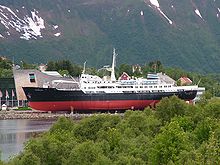Norwegian Coastal Express Museum
68°34′13″N 014°54′38″E / 68.57028°N 14.91056°E

The Norwegian Coastal Express Museum (Norwegian: Hurtigrutemuseet) is located at Richard Withs plass (Richard With Square) in Stokmarknes[1] in Nordland county—a natural location because the Coastal Express was "born" here. The museum is operated by the Coastal Express Museum Association and it includes the former coastal express ship MS Finnmarken from the Vesterålen Steamship Company.[2]
The museum was officially opened by Transport Minister Kjell Opseth on July 2, 1993—the 100th anniversary of the first coastal express voyage.[1][2] The museum then received its premises in the old administration building of the Vesterålen Steamship Company. In 1999 the museum was relocated to a new location in the Coastal Express Building (Hurtigrutens Hus) next to the Coastal Express dock.[3][4]
Purpose[edit]
The articles of association of the Coastal Express Museum Association state that "The purpose of the association is to establish and operate a Coastal Express Museum at Stokmarknes."[1] The association's tasks consist of maintaining and preserving buildings and objects belonging to the museum. This is done in cooperation with the responsible professionals at the Vesterålen Museum in Melbu. The museum showcases the history of the Coastal Express for visitors and is an information center for coastal culture and a professional resource for schools, institutions, and organizations involved in cultural protection.[1]
History[edit]

The first idea for creating a museum in Stokmarknes dedicated to the Coastal Express took shape in 1980. During the 1980s, the concept was developed into a plan and a project. An interim administration for the museum was elected in 1989, and that same year the Coastal Express Museum Association was founded. In the summer of 1991 the museum was unofficially opened; it was still limited in size and being developed. The museum was officially opened on July 2, 1993 by Transport Minister Kjell Opseth on the centenary of the day that SS Vesteraalen started the first voyage from Trondheim on the coastal express route. One year later, the museum received an enormous gift from the Ofoten and Vesteraalen Steamship Company: the retired coastal express ship MS Finnmarken (1956). On May 3, 1999, the ship traveled to the Kaarbø Shipyard in Harstad for sandblasting and preparation for moving it to land. On June 16, 1999 MS Finnmarken left the water and was put on display at the Coastal Express Museum.[5] It is one of the world's largest museum pieces. The state paid for transferring the ship to land, but explicitly stated that the museum's operating costs had to be covered locally.
The ship has been exposed to water intrusion since it was moved to land.[6] A temporary roof and tarpaulin were installed on the ship in an effort to limit moisture damage while discussing how and whether MS Finnmarken is to be preserved.[7] A committee led by the Nordland county municipality delivered its report on January 25, 2007. Several solutions were outlined, including installing a new building around the entire ship at a cost of NOK 70 to 140 million. The cheapest option is to cut up the ship (at a cost around NOK 19 million). A third possibility is to let the ship stand outdoors as it is now, with minor superstructures at a cost of NOK 36 million. The report concludes that most of the costs of the Coastal Express Museum are connected with maintaining MS Finnmarken. The state has shown little willingness to take over the operation of the Coastal Express Museum, but it provided funds to build the temporary roof to prevent further deterioration while discussing the matter. The Ministry of Transport and Communications insists that local funding of the museum's operation was a prerequisite when funds were provided to move the ship to land.[8]
At the beginning of 2009, the Coastal Express Museum and Hurtigruten AS entered into an agreement that round-trip passengers on the express route would receive free admission to the museum in return for the museum receiving NOK 25 per visitor from the express route. This led to a 140% increase in visitor numbers in the first quarter of 2009 of compared to the first quarter of 2008.[9]
On February 25, 2009, the Nordland County Council approved a grant of NOK 20 million to the Coastal Express Museum, with the prerequisite that the municipality of Hadsel contribute another 20 million, and the state 60 million.[10] On June 18, 2009, the Hadsel Municipal Council decided to provide guarantees of NOK 20 million. Including the government's contribution, NOK 100 million will be made available to build a permanent protective structure over MS Finnmarken. It was also decided to establish a municipal enterprise to build and serve as the owner of a newer and more compact Coastal Express Museum.[11]
References[edit]
- ^ a b c d "Hurtigrutemuseet på Stokmarknes". Hurtigrutemuseet. Retrieved September 8, 2018.
- ^ a b Möbius, Michael; Möbius, Aaron (2014). Stefan Loose Reiseführer Norwegen mit Reiseatlas. Ostfildern: DuMont Reiseverlag. p. 504.
- ^ Jensen, Tor Johannes (November 17, 2017). "Nå blir det virkelig!". Bladet Vesterålen. Retrieved September 8, 2018.
- ^ Bille, Mikkel; Sørensen, Tim Flohr (2016). Elements of Architecture : Assembling Archaeology, Atmosphere and the Performance of Building Spaces. London: Routledge.
- ^ Jensen, Tor Johannes (January 11, 2018). "Nå feirer de Hurtigruta – og museet". Bladet Vesterålen. Retrieved September 10, 2018.
- ^ Lyngmoe, Helge; Pedersen, Bjørn Tore (May 29, 2009). "'Finnmarken' reddet?". NRK. Retrieved September 11, 2018.
- ^ Rønning, Oliver (October 12, 2017). "Nytt hurtigrutemuseum kan ryke: – Nå henger prosjektet i en tynn tråd". NRK.
- ^ "Skriftleg spørsmål fra Jan Sahl (KrF) til samferdselsministeren". Stortinget. Retrieved September 11, 2018.
- ^ "Besøksrekord på Hurtigrutemuseet". Bladet Vesterålen. March 31, 2009.
- ^ Helland, Monica; Olsen, Knut Eirik (February 25, 2009). "20 millioner til Hurtigrutemuseet". NRK. Retrieved September 12, 2018.
- ^ "Klappet for hurtigrutemuseet". Bladet Vesterålen. June 18, 2009.
